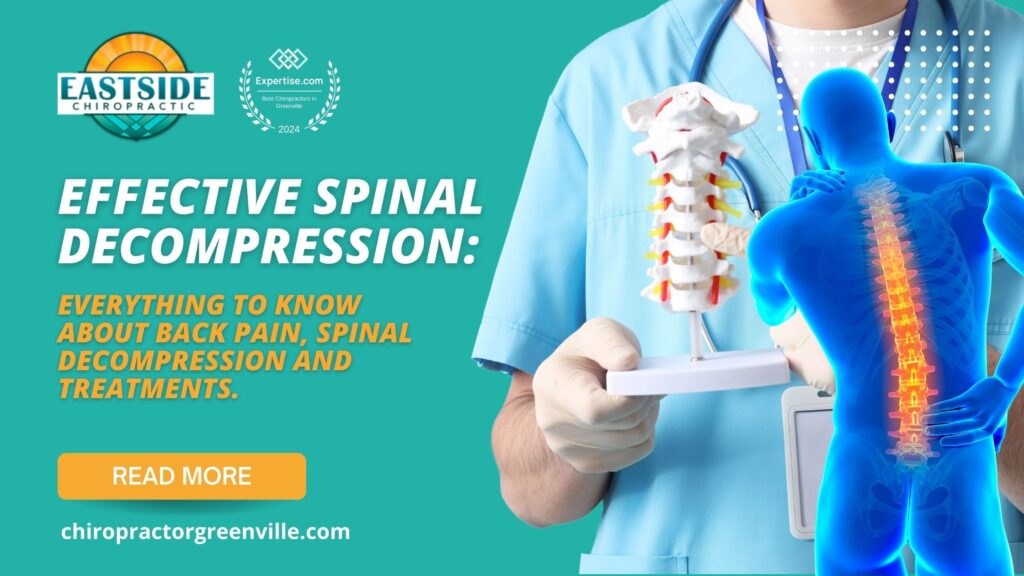Spinal Decompression at Eastside Chiropractic PA: Understanding the Side Effects and Risks
Introduction
Welcome to Eastside Chiropractic PA in Taylors, SC! Today, we’re diving into an exciting yet crucial topic about spinal decompression therapy. Spinal decompression can offer much-needed relief for those suffering from chronic back pain, but it’s essential to understand the full picture, including the side effects and risks involved. So, let’s get started!
What is Spinal Decompression?
Spinal decompression is a non-surgical therapy used to alleviate back pain and other discomforts associated with spinal problems. The technique involves stretching the spine to relieve pressure on spinal discs, nerves, and joints.
Types of Spinal Decompression
- Mechanical Decompression: Utilizes a specialized table and mechanical traction.
- Manual Decompression: Conducted by a skilled practitioner using hands-on techniques.
Benefits of Spinal Decompression
Spinal decompression can help with various conditions like herniated discs, sciatica, and degenerative disc disease, providing pain relief and improving mobility.
Why Consider Spinal Decompression?
If you’re suffering from chronic back pain or related ailments, spinal decompression might be a viable option for you.
Common Conditions Treated
- Herniated Discs
- Sciatica
- Spinal Stenosis
- Degenerative Disc Disease
How It Works
By gently stretching the spine, the therapy creates negative pressure within the discs, allowing for herniated or bulging discs to retract and heal.
Testimonials and Success Rates
Many patients have experienced significant relief and improved quality of life. With success rates averaging around 70-80%, it’s no wonder spinal decompression is growing in popularity.
Understanding the Side Effects of Spinal Decompression
While spinal decompression is minimally invasive, being aware of potential side effects can help you make an informed decision.
Immediate Side Effects
- Muscle Spasms: Some patients may experience muscle spasms during or after the procedure.
- Soreness: It’s common to feel some soreness in the treated area.
- Increased Pain: In rare cases, existing pain may temporarily intensify before it improves.
Long-term Side Effects
There are generally no long-term side effects, but it’s always best to consult with your chiropractor.
Common Spinal Decompression Risks
Although spinal decompression is considered safe, no medical procedure is risk-free.
Risk Analysis
- Nerve Damage: Very rare but possible, particularly if underlying conditions are present.
- Worsening of Symptoms: Improper treatment can exacerbate symptoms.
Pre-existing Conditions That May Increase Risks
Patients with osteoporosis, fractures, or certain types of cancer might face higher risks.
Comparison with Surgical Alternatives
Unlike surgery, spinal decompression has a lower risk profile and shorter recovery time.
Who Should Avoid Spinal Decompression?
Not everyone is a candidate for spinal decompression.
Contraindications
- Severely overweight individuals
- Pregnant women
- Those with abdominal aortic aneurysm
Situations Where It Might Not Be Appropriate
If you have a history of spinal fusion surgery, careful evaluation is necessary.
Ensuring Safety During the Procedure
Your safety is our top priority at Eastside Chiropractic PA.
Professional Assessment
Our team conducts a thorough assessment to determine your suitability for spinal decompression.
State-of-the-Art Equipment
We use the latest technology to ensure precise and effective treatments.
Customization and Monitoring
Each treatment plan is customized and closely monitored to minimize risks.
Patient Experiences and Studies
Real-life experiences and scientific studies provide valuable insights into the effectiveness and safety of spinal decompression.
Anecdotal Experiences
Many patients report significant pain relief and improved mobility.
Research and Findings
Studies have shown favorable outcomes, particularly for those with herniated discs and sciatica.
Case Studies
Personalized treatment plans have resulted in positive outcomes for many patients at Eastside Chiropractic PA.
Preventive Measures for Reducing Risks
Here are some steps to ensure a safer experience with spinal decompression.
Patient Education
Informed patients are better prepared and more likely to follow post-treatment care guidelines.
Pre-treatment Assessments
Comprehensive assessments help identify any potential risks or contraindications.
Follow-up Care
Regular follow-ups are essential to monitor progress and address any concerns.
Alternative Treatments
For those who might not be suitable candidates for spinal decompression, several other non-surgical options are worth considering.
Overview of Other Non-Surgical Options
- Physical Therapy
- Chiropractic Adjustments
- Pain Relief Injections
Comparing Efficacy and Safety
Each treatment has its pros and cons, but spinal decompression often stands out for its non-invasive nature and effectiveness.
What to Expect During a Spinal Decompression Session
Initial Consultation
During the initial consultation, your chiropractor will gather information about your medical history and current symptoms.
The Procedure Itself
The procedure involves you lying on a motorized table while a harness is placed around your pelvis. The table gently stretches your spine, creating negative pressure to relieve pain.
Post-treatment Care
You may be advised to follow specific exercises and stretches to enhance the treatment’s effects.
Recovering from Spinal Decompression
Typical Recovery Process
Most patients experience gradual improvement over a few weeks.
Long-term Care and Maintenance
Regular follow-ups and a tailored exercise routine can help sustain the benefits.
Tips for Sustained Benefits
Maintaining a healthy weight, staying active, and following your chiropractor’s advice can help you enjoy long-lasting relief.
Conclusion
Spinal decompression is a promising treatment option for many suffering from chronic back pain. With a detailed understanding of the potential side effects and risks, you can make an informed decision. At Eastside Chiropractic PA in Taylors, SC, we’re here to help you every step of the way.
FAQs
Is spinal decompression painful?
No, most patients find the process relaxing, although some may experience mild discomfort or soreness initially.
How long does each session last?
Each session typically lasts between 30 and 45 minutes.
How many sessions are typically needed?
It varies, but a typical course involves around 15-20 sessions over several weeks.
Are the effects of spinal decompression permanent?
While many patients experience long-term relief, maintenance sessions may be needed.
Can everyone benefit from spinal decompression?
Not everyone; a thorough assessment is essential to determine if you’re a suitable candidate.
